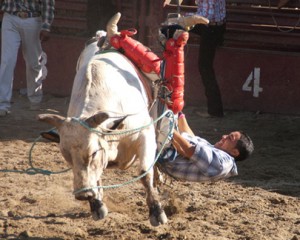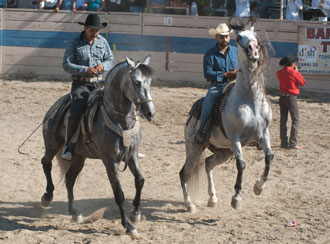Bravo for the Brave Charros and Bulls!
By Bette Isis Holmquist August 25, 2010The charro arena, located at the west end of the Hansen Dam Equestrian Center in Lake View Terrace, is normally a quiet, dusty, even mysterious place. But on July 25 it was anything but. Five hours of fast action, south-of-the-border family entertainment featuring brave bulls, charros y charras, song, brass bands and mariachi strings, and, of course, gorgeous Spanish horses drew about 1,200 spectators, shouting “ándale” and “olé, mis amigos.” It was a spectacle, indeed.
Charro is Mexican rodeo. Filmmaker Chris Weitz (The Twilight Saga: New Moon) shot scenes at Los Angeles–area charro events this past summer for inclusion in his upcoming movie The Gardener, scheduled for release in 2011. But if you’ve never experienced charro, you won’t have to wait to see the movie. There are many such events that take place throughout the year in Southern California, which is second only to Texas in terms of charro in the U.S.
As visitors found seats around the arena, colorful bull-teasing clowns with red capas capered and sang with the vaqueros. The day was sunny and hot, but the event’s organizers, José and Eduardo De Los Santos, had thoughtfully erected a mesh screen above the seats. Along with a cool breeze off the Hansen Dam wash, it was a comfortable viewing environment.
The program started with a parade. There were children, flag-waving charros on Andalusians, Aztecas, Quarter Horses and Thoroughbreds and a brass band. A moment of silence graced the arena as white and black hats disappeared, and a prayer was said for the bulls, the horses, the vaqueros and the riders.
Soon the arena was alive with whistling and yelling, as a bull and rider cut loose out of the chute. The bull rose to the occasion, frantically jack-knifing to be free not only of the rider, but of the strap placed around its flank. The “eight-second rule” was enforced. After eight jumps, the charros and vaqueros were free to stabilize the bull by lassoing him with their riatas, enabling the rider to safely dismount the animal’s back.

Charreada combines traditional rodeo events, like bull riding, with cultural pageantry. (Photo by Locus-Ford/MicroArtisans)
Occasionally a bull feels lost and cannot locate the exit gate. At this point, another bull is sent into the arena in order to guide the first bull out. Though bovines have gotten a reputation for being brutish and dull, the charro display left an impression of them as magnificent, powerful and intelligent creatures.
One rider amazed the fans as he stayed on while the bull spun around rapidly 21 times! Often the bull riders travel up to the States from provinces in Mexico, such as Jalisco and Michoacan. One such rider called Gay La Guera began his career in Oaxaca when he was 15 years of age. His family tried to discourage him, but he persevered to become one of the foremost bull riders in Mexico, explained the gentleman sitting next to me, Catalino Villamil, whose father rode 360 bulls during his career in Mexico. (Catalino was also very helpful in translating the announcer’s commentary, delivered in Spanish.)
Following the bull-riding event, a Mexican-style family horse show was presented. Such shows, say the event organizers, serve to showcase the many ways to enjoy horses. Indeed, the charro tradition is steeped in family values. Governed by the Mexican Charro Federation, the sport includes many competitive events and has charreada disciplines for female riders.
Several farms, including Rancho los Corceles, an alta escuela (the Mexican version of haute ecole) performance

Andalusian horses are schooled in passage, piafffe and the Spanish Walk. (Photo by Locus-Ford/MicroArtisans)
school owned by Alejandro Luna of Perris, provided the event with lovely Andalusian horses that performed piaffe and passage and the Spanish walk. The double long-line act was beautifully executed. Alejandro (aka “Cano El Chilango”) in his formative years worked for a famous equestrian school in Mexico called Pedro Domec. His horses have been ridden by many well-known singers. At the Hansen Dam event, fans experienced the voluptuous voices of Casandra and Poberty Montes, who belted their tunes from horseback, circling the arena astride their magnificent mounts. Jessica Hernandez and Omar Ariola also performed. Bravo to all!
The De Los Santos team’s next event is scheduled for Aug. 15 at Hansen Dam and will include displays of escaramuza, six to 12 horsewomen riding choreographed patterns in fancy dress, and ballet folklorico in additional to the equestrian activities.
Short URL: https://theequestriannews.com/?p=2976



